Your Call?
Which of today’s three featured images is the strongest? All are invited to leave a comment and let us know why they made their choice. Though I love all three, I do have a clear favorite and will share that here with you tomorrow.
What’s Up?
Thursday morning on the Hooptie Deux was about the best ever for pelican flight. With cloudy bright skies followed by mostly sunny and a brisk southeast wind we had one pelican after another coming in high with beaks full of nesting material. It was pretty much like shooting fish in a barrel. Right before — filling a Delkin Devices 160GB BLACK CFexpress Type A Memory Card –(something that I rarely do), we had an adult pelican fly in carry a large branch from a live tree replete with leaves and seed pods. It hung in the air above the mangroves seemingly forever. That turned out to be well less than 3 seconds, an eternity when photographing birds in flight. During that brief time, I held the hammer down and created 68 images, every one sharp on the bird’s eye. I created 3400 as yet un-culled images. I got some great images of an incoming oystercatcher and am pretty sure that I got a few other good ones as well.
Huge thanks to Mike and Norma De Rosa and Garry Chappel for joining me. The four of us shared a gorgeous spacious AirBnB and had a wonderful time along with some great meals (cooked by me). Mike continued to work on improving his basic skills: getting the right exposure for JPEGs, and properly framing flight shots. Gary is an excellent photographer who arrived never using a teleconverter. I quickly had him working successfully with his Sony 600 f/4 and the .4X TC.
Today is Friday 17 February 2023. I still have a ton of packing to do for my trip to Alaska for eagles. Jim will be dropping me off at an airport hotel on his way home on Friday afternoon. I have an early flight to Seattle and then continue on to Anchorage. I will pick up a big SUV at the airport and then overnight there with participant Bob Eastman and Carolyn Johnson. We are planning on having dinner at the amazing So Thai and then driving down to Homer leaving early the next morning. Wish us luck (i.e., no blizzard).
If you have some cold weather gear and are free from about 23 or 24 February through March 3 or 4 and would like to join the second Homer IPT, please get in touch via e-mail ASAP as I am practically giving away the second IPT for free.
This blog post took about two hours to prepare and makes three hundred twenty-five days in a row with a new educational post written just for you. Wherever you are and whatever you are doing, I hope that you too have a great day.
Please, please, pretty please remember to use m B&H or Bedford’s affiliate programs for all your new gear purchases. If you use B&H, please be sure to click on any B&H link in the blog to start your search. Or simply start with this link. There is always the option of e-mailing me for gear advice and for the correct links.
The plan is to continue to post every day until the streak reaches one year and one day and then posting every other day.
Please remember to use the B&H and Amazon links that are found on most blog pages and to use the BIRDSASART discount code at checkout when purchasing your new gear from Bedfords to get 3% back on your credit card and enjoy free second-day air FedEx. Please, also, consider joining a BAA IPT. You will be amazed at how much you will learn!
You can find some great photo accessories (and necessities, like surf booties!) on Amazon by clicking on the Stuff tab on the orange/yellow menu bar above. On a related note, it would be extremely helpful if blog-folks who, like me, spend too much money on Amazon, would get in the habit of clicking on the Amazon logo link on the right side of each blog post when they shop online. As you might expect, doing so will not cost you a single penny, but would be appreciated tremendously by yours truly. And doing so, works seamlessly with your Amazon Prime account.
Please remember that if an item — a Delkin flash card, or a tripod head — for example, that is available from B&H and/or Bedfords, is also available in the BAA Online Store, it would be great, and greatly appreciated, if you would opt to purchase from us. We will match any price. Please remember also to use my B&H affiliate links or to earn 3% cash back at Bedfords by using the BIRDSASART discount code at checkout for your major gear purchases. Doing either often earns you free guides and/or discounts. And always earns my great appreciation.
Induro GIT 304L Tripod
Price reduced $50.00 on 16 FEB 2023
Out of production for more than two years, BAA sold its last one in December. The good news? We have two more new-in-the-box tripods. They are now available for only $649.00 (were $699.00). The 304L was my go-to tripod for more than a decade. Best to grab order yours right now by clicking here to avoid being disappointed.
|
|
|
This image was created on 2 January 2023 at La Jolla, CA. Standing at full height, I used the handheld Sony FE 400mm f/2.8 GM OSS lens and The One, the Sony Alpha 1 Mirrorless Digital Camera). The exposure was determined via Zebra technology with ISO on the Thumb Dial. ISO 2000. 1/1320 sec. at f/2.8 (wide-open) in Manual mode. When evaluated in RawDigger, the raw file brightness was determined to be dead-solid perfect (ho hum). AWB at 8:35:13am on hazy, sunny morning. Tracking: Spot S AF-C with Bird Face/Eye detection enabled performed to perfection. Be sure to click on the image to enjoy a high-res version. Image #1: Brown Pelican on final approach |
Why Wide-Open?
An e-mail Conversation with William Gingras
WG: Hi Artie
I noticed that with a majority of the pictures you post to your website, no matter the lens selection, you tend to shoot wide-open. Is there a particular reason for that?
AM: Thanks for writing, Bill. The short answer, as I am pretty sure is detailed in both the original The Art of Bird Photography and in the digital follow-up on CD, The Art of Bird Photography II, is that since bird photographers are always fighting for shutter speed while avowing high ISO, the wide-open aperture is often best. Remember, that is the short answer so keep reading.
WG: Am I missing something?
AM: Actually, you have been missing a lot as I have covered this topic on the blog very often in the last few months. Here is some of what you missed:
a- If the bird is relatively distant, you have a lot more depth of field than you think. I have recommended many times that folks consult the PhotoPills DEPTH OF FIELD (DOF) CALCULATOR and do some serious studying. Here is how I would do that for today’s featured images, each shot at the wide-open aperture — f/2.8. The distance to the subject was 39.88 meters (from a7INFO). With a focal length of 400mm on a full frame sensor body, the dof in front of the point of focus is 0.82 meters (2.7 feet!) and 0.85 meters (2.8 feet!) behind. That totals to more than five feet, are more than enough to cover virtual any pelican wing position. And that goes double when the bird is flying right at us.
When most folks see an aperture of f/2.8 they think “narrow depth of field” because they do not consider the distance to the subject.
b- As above, depth of field increases exponentially as the distance to the subject increases.
c- What you see is what you get. If the entire bird looks sharp through the viewfinder it will be sharp in the final image.
d- The only time that you need to be concerned about using smaller apertures to gain additional depth of field is when you are relatively close to a subject.
e- Unless you can clearly state a reason to stop down (use a smaller aperture), use the wide-open aperture.
I hope that the above helps. Let me know if you have any additional questions.
WG: Hope you are having a wonderful day. Thanks, Bill G
AM: Thanks. I did! B sure to scroll down to the next item for an additional dof tip.
|
|
|
This image was created on 2 January 2023 at La Jolla, CA. Standing at full height, I used the handheld Sony FE 400mm f/2.8 GM OSS lens and The One, the Sony Alpha 1 Mirrorless Digital Camera). The exposure was determined via Zebra technology with ISO on the Thumb Dial. ISO 2000. 1/1320 sec. at f/2.8 (wide-open) in Manual mode. When evaluated in RawDigger, the raw file brightness was determined to be dead-solid perfect (ho hum). AWB at 8:35:13am on hazy, sunny morning. Tracking: Spot S AF-C with Bird Face/Eye detection enabled performed to perfection. Be sure to click on the image to enjoy a high-res version. Image #2: Brown Pelican braking to land |
A New Approach to Understanding DOF
I have been meaning to share this tip with you here for some time. Thanks to Bill Gingras for reminding me to do that with his e-mail question.
Every once in while, when you are working on a tripod with a long lens, photographing a bird at some distance, and already have a few good images, take a moment to learn a ton about depth of field. You will need to have your camera’s Focus Peaking feature turned on. Use autofocus to focus on the bird’s eye and then turn off autofocus by moving the AF with to MF (manual focus). This will activate the color overlay that shows the parts of the bird that are in focus. Unless you are pretty close to the bird, the color overlay will show that the entire bird is well covered by the available depth of field.
It’s a great way to learn about depth of field.
|
|
|
This image was created on 2 January 2023 at La Jolla, CA. Standing at full height, I used the handheld Sony FE 400mm f/2.8 GM OSS lens and The One, the Sony Alpha 1 Mirrorless Digital Camera). The exposure was determined via Zebra technology with ISO on the Thumb Dial. ISO 2000. 1/1320 sec. at f/2.8 (wide-open) in Manual mode. When evaluated in RawDigger, the raw file brightness was determined to be dead-solid perfect (ho hum). AWB at 8:35:13am on hazy, sunny morning. Tracking: Spot S AF-C with Bird Face/Eye detection enabled performed to perfection. Be sure to click on the image to enjoy a high-res version. Image #3: Brown Pelican “orchestra leader pose” |
The 400mm f/2.8 in San Diego
When I chose to ship my 600mm f/4 GM lens to San Diego and carry the 400 f/2.8 in my Think Tank rolling bag, I had no idea that there would be more clouds and more stormy weather in San Diego than I had ever experienced, and had no idea that the 400 f/2.8 would be so valuable, especially for flight photography. When I stood well back from the landing area, the focal length was perfect for framing the incoming pelicans and with the super-wide f/2.8 aperture, Bird Face/Eye detection works considerably better than with an f/4, f/5.6, or f/6.3 lens. The tiny green box picks up and tracks the bird’s eye with astounding speed and accuracy.
Not to mention that the super-fast f/2.8 aperture allowed for fast shutter speeds on lousy weather days without having to use ridiculously high ISO settings.
Though the 400 f/2.8 is only four ounces lighter than the 600 f/4, it is light-years easier for me to handhold for flight photography. Why? The 400mm is shorter and far less bulky than the 600mm. In addition, it is far better balanced with more of the weight to the rear of the lens. When I get on the plane on Saturday morning, the 400mm f/2.8 will be in my rolling bag while the 600 f/4 will be sitting in my air-conditioned garage. Aside from most of my Galapagos trips, it will be the first time in several decades that I will be getting on a flight without my longest telephoto lens.
|
|
|
This all-new card includes images created on my JAN 2022 visit to San Diego. Click on the composite to enjoy a larger version. |
The 2023/2024 San Diego Brown Pelicans (and more!) IPTs
San Diego IPT #1. 3 1/2 DAYS: WED 27 DEC thru the morning session on Saturday 30 DEC 2023. $2099.00. Deposit: $699.00. Limit: 6 photographers.
San Diego IPT #2. 4 1/2 DAYS: TUES 9 JAN thru the morning session on SAT 13 JAN 2024: $2699.00. Deposit: $699.00. Limit: 6 photographers.
San Diego IPT #3: 4 1/2 DAYS: TEUS 23 JAN thru the morning session on SAT 27 JAN 2024: $2699.00. Deposit: $699.00. Limit: 6 photographers.
Please e-mail for information on personalized pre- and post-IPT morning sessions.
Join me in San Diego to photograph the spectacular breeding plumage Brown Pelicans with their fire-engine red and olive green bill pouches; Brandt’s (nesting) and Double-crested Cormorants; breeding plumage Wood and Ring-necked Ducks; other duck species possible including Lesser Scaup, Redhead, Northern Shoveler and Surf Scoter; a variety of gulls including Western, California, and the gorgeous Heermann’s, all in full breeding plumage; shorebirds including Marbled Godwit, Willet, Sanderling and Black-bellied Plover; many others are possible including Least, Western, and Spotted Sandpiper, Whimbrel, Black and Ruddy Turnstone, Semipalmated Plover, and Surfbird; Harbor Seals and California Sea Lions (both depending on the current regulations and restrictions). And as you can see by studying the IPT cards, there are some nice bird-scape and landscape opportunities as well. Not to mention a ton of excellent flight photography opportunities and instruction.
I discovered some really neat spots on my 2022/23 visit. As a result, the first and second IPTs may include an afternoon or two of landscape photography.
Please note: where permitted and on occasion, ducks and gulls may be attracted (or re-located) with offerings of grains or healthy bread.
|
|
|
San Diego offers a wealth of very attractive natural history subjects, including and especially the Pacific race of California Brown Pelican. With annual visits spanning more than four decades, I have lots of photographic experience there … Click on the composite to enjoy a larger version. |
Learning Exposure, Whether You Like It Or Not
Whether you like it or not, we will be beating the subject of exposure like a dead horse. In every new situation, you will hear my thoughts on exposure along with my thoughts on both Nikon and Canon histograms and SONY Zebras. Whether you like it or not, you will learn to work in manual mode so that you can get the right exposure every time (as long as a bird gives you ten seconds with the light constant). Or two seconds with SONY zebras … And you will learn what to do when the light is changing constantly. What you learn about exposure will be one of the great takeaways on every IPT.
|
|
|
Though the pelicans will be the stars of the show on this IPT, there will be many other handsome and captivating subjects in wonderful settings. Click on the composite to enjoy a larger version. |
It Ain’t Just Pelicans
With gorgeous subjects just sitting there waiting to have their pictures taken, photographing the pelicans on the cliffs is about as easy as nature photography gets. With the winds from the east almost every morning, there is usually some excellent flight photography, at times with 70-200mm lenses! And the pelicans are almost always doing something interesting: preening, scratching, bill pouch cleaning, or squabbling. And then there are those crazy head throws that are thought to be a form of intra-flock communication. You will be guided as to how to make the best of those opportunities. Depending on the weather, the local conditions, and the tides, there are a variety of other fabulous photo chances available in and around San Diego. Each IPT will include one or two duck sessions.
|
Did I mention that there are lots of great birds and natural history subjects in San Diego in winter? Click on the composite to enjoy a larger version. |
The San Diego Details
These IPTs will include four or five 3-hour morning photo sessions, three or four 1 1/2-hour afternoon photo sessions, and three or four working brunches that will include image review and Photoshop sessions. On rare cloudy days, we may — at the leader’s discretion, stay out in the morning for a long session and skip that afternoon shoot. To ensure early starts, breakfasts will be your responsibility. And so that we can get some sleep, dinners will be on your own as well. In the extremely unlikely event that Goldfish Point is closed due to local ordinance (or whimsy) — that has never happened in the past fifty years, I will of course do my very best to maximize our photographic opportunities.
|
|
|
San Diego offers a wealth of very attractive natural history subjects, including and especially the Pacific race of California Brown Pelican. With annual visits spanning more than four decades, I have lots of photographic experience there … Click on the composite to enjoy a larger version. |
Deposit Info
A $699 deposit is required to hold your slot for one of the 2023/2024 San Diego IPTs. You can send a check (made out to “BIRDS AS ART”) to us here: BIRDS AS ART, PO Box 7245, Indian Lake Estates, FL, 33855, or call Jim or Jennifer at the office with a credit card at 863-692-0906. Your balance, payable only by check, is due three months before the trip.
|
Variety is surely the spice of life in San Diego. Click on the composite to enjoy a larger version. |
Getting Up Early and Staying Out Late
On all BIRDS AS ART IPTS including and especially the San Diego IPT, we get into the field early to take advantage of unique and often spectacular lighting conditions and we stay out late to maximize the chances of killer light and glorious sunset silhouette situations. We often arrive at the cliffs a full hour before anyone else shows up to check out the landscape and seascape opportunities.
Typos
With all blog posts, feel free to e-mail or to leave a comment regarding any typos or errors.

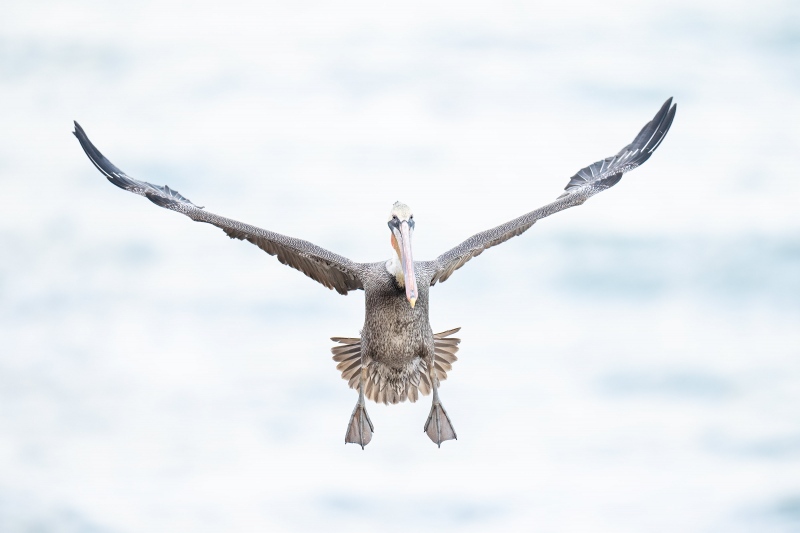
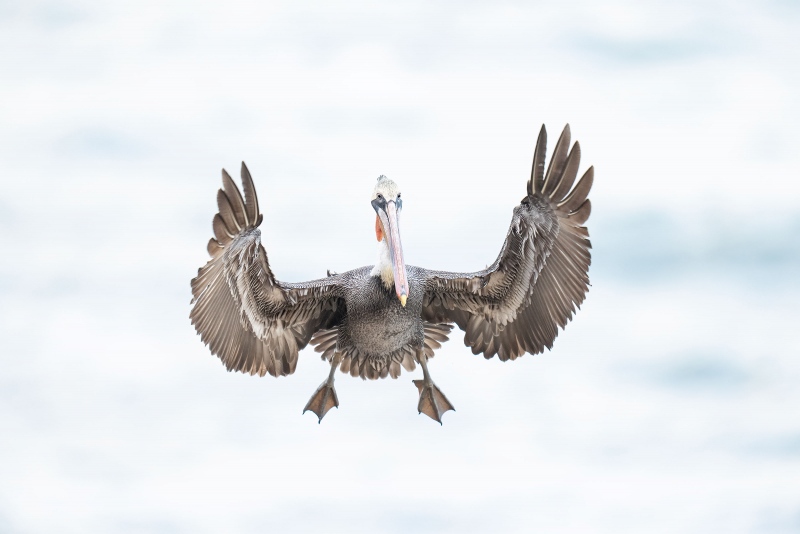
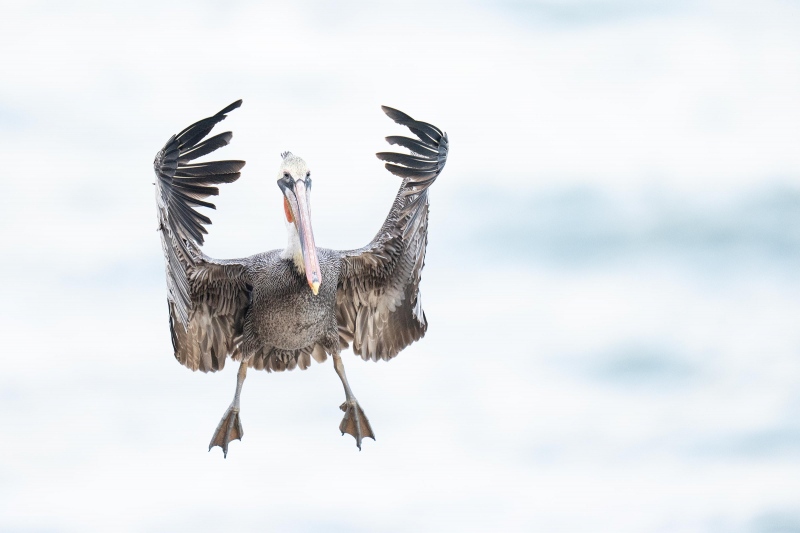
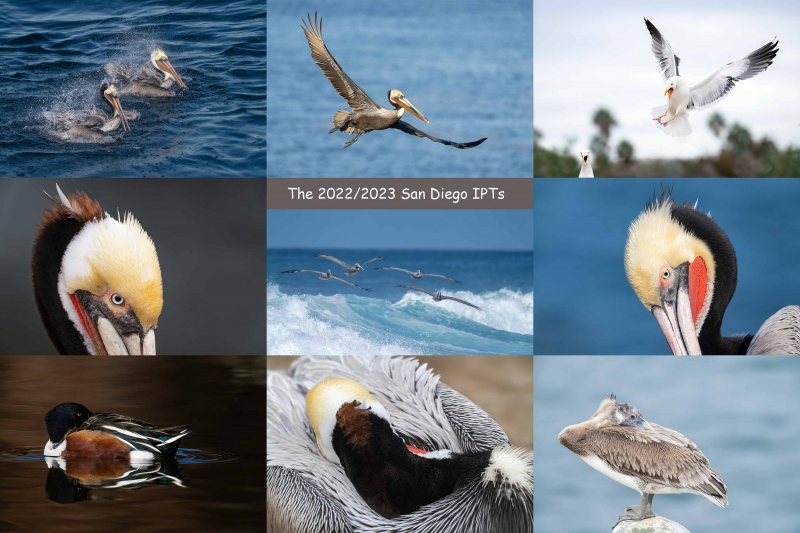
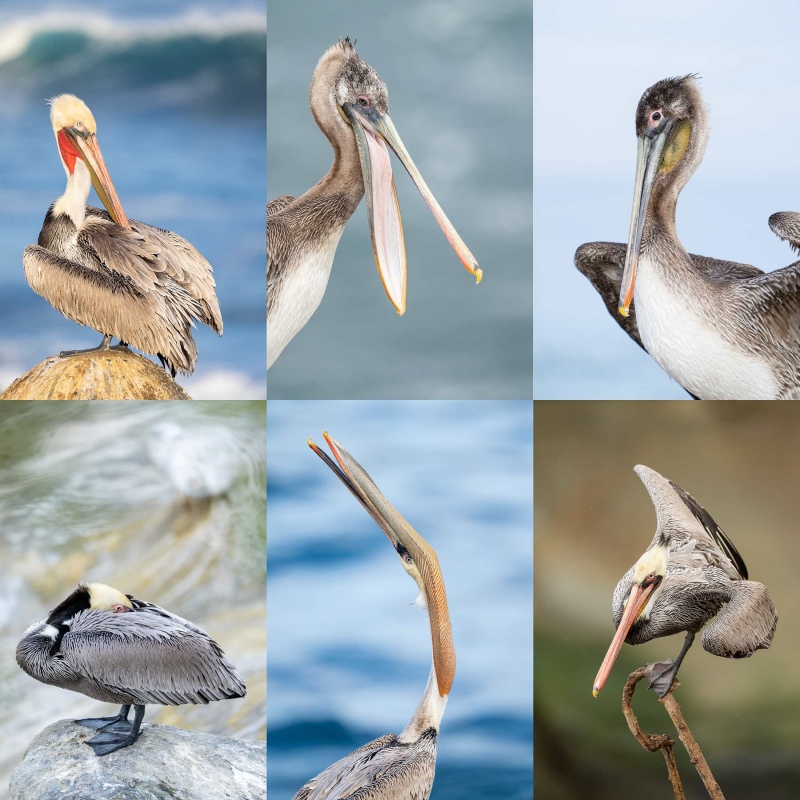
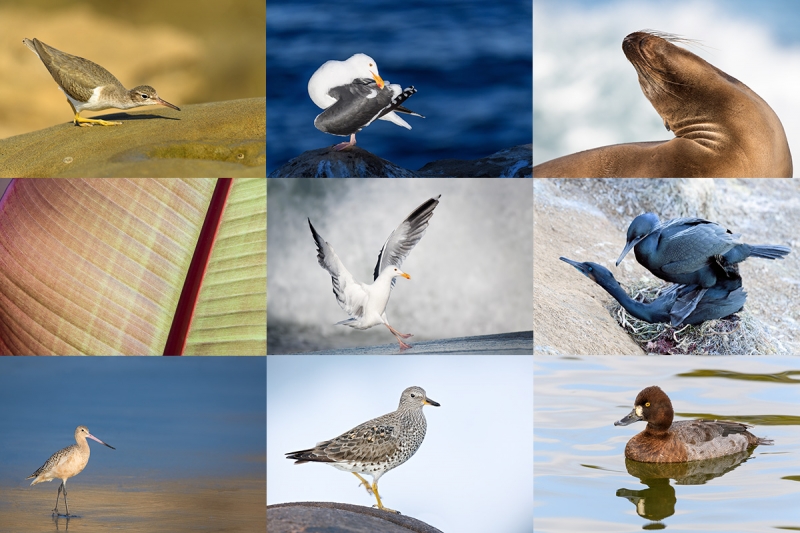

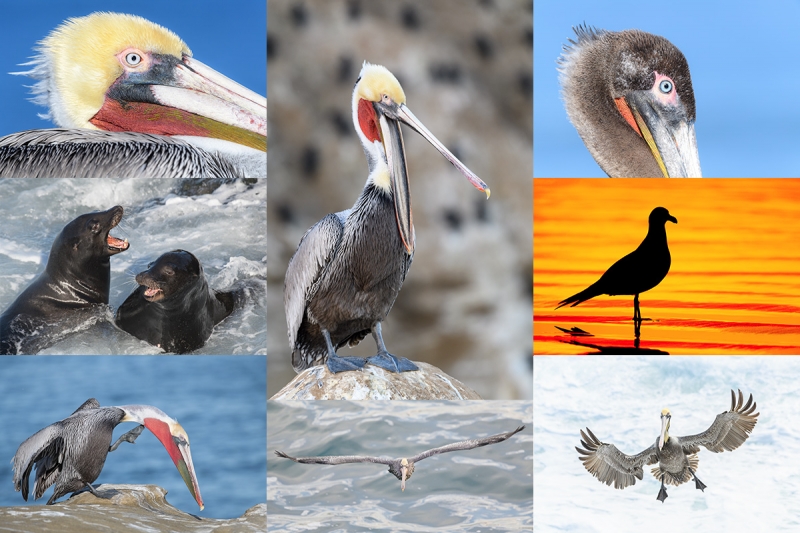














The sequence works for me as a progressive revelation of CHARACTER. The shots becomes less “anonymous.” So #3 is my favorite, not so much as a conductor but as a statement from the pelican, pointing at him- or herself with the individualized wingtips: “Look at me, Man-with-Camera, look at what I can do and you can’t.” (Anthropomorphism?)
(By “individualized wingtips” I mean in comparison with #2, where they look comparatively similar. In #3, left and right are very different, implying a unique pelican.)
(#2 is very nice, though, expressing modesty: “Please, no applause.”)
Hey Walter,
Thanks for your thoughtful analysis.
with love, artie
All three images of Brown Pelican are interesting and cute and well made! I like all three images!
Image 3 I like best.
Artie
Looks like an orchestra leader leading the musicians as the first one gets all ready than the second Q’s up the whole band and finally the jam is on! “Rock On” love them all
Always with love b
See you in Anchorage. Remember, BIBO!
With love, artie
They are all nice shots but my favorite is number three. Number one is more of a standard shot. Number three looks more interesting than number two. I like the orchestra leader! (Hope I haven’t struck a sour note with anyone…)
Artie, number 2 works best for me. Almost looks like a puffin coming in for landing and floating in the air.
#2 all day for me. Love the floppy feet on all, but the wings in the brake position make #2 my favorite.
Artie, I prefer #2. Symmetry of the pelican and great feather detail.